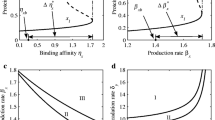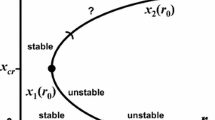Abstract
In this paper, we develop a network-based methodology to investigate the problems related to matrix stability and bifurcations in nonlinear dynamical systems. By matching a matrix with a network, i.e., interaction graph, we propose a new network-based matrix analysis method by proving a theorem about matrix determinant under which matrix stability can be considered in terms of feedback loops. Especially, the approach can tell us how a node, a path, or a feedback loop in the interaction graph affects matrix stability. In addition, the roles played by a node, a path, or a feedback loop in determining bifurcations in nonlinear dynamical systems can also be revealed. Therefore, the approach can help us to screen optimal node or node combinations. By perturbing them, unstable matrices can be stabilized more efficiently or bifurcations can be induced more easily to realize desired state transitions. To illustrate feasibility and efficiency of the approach, some simple matrices are used to show how single or combinatorial perturbations affect matrix stability and induce bifurcations. In addition, the main idea is also illustrated through a biological problem related to T cell development with three nodes: TCF-1, GATA3, and PU.1, which can be considered to be a three-variable nonlinear dynamical system. The approach is especially helpful in understanding crucial roles of single or molecule combinations in biomolecular networks. The approach presented here can be expected to analyze other biological networks related to cell fate transitions and systematic perturbation strategy selection.









Similar content being viewed by others
Data availibility
No public data are used.
References
Abidemi A, Ackora-Prah J, Fatoyinbo HO, Asamoah JKK (2022) Lyapunov stability analysis and optimization measures for a dengue disease transmission model. Phys A 600:127646
Anderson MK, Hernandez-Hoyos G, Dionne CJ et al (2002) Definition of regulatory network elements for T cell development by perturbation analysis with PU. 1 and GATA-3. Dev Biol 246(1):103–121
Angeli D, Ferrell JE Jr, Sontag ED (2004) Detection of multistability, bifurcations, and hysteresis in a large class of biological positive-feedback systems. Proc Natl Acad Sci USA 101(7):1822–1827
Barsuk AA, Paladi F (2021) On the stability of equilibrium states of the dynamical systems in critical cases. Phys A 569:125787
Burke JV, Lewis AS, Overton ML (2002) Two numerical methods for optimizing matrix stability. Linear Alg Appl 351:117–145
Chen L, Xing X, Yang S (2022) Symmetry-breaking instability in a charge-controlled dielectric film: large electro-actuation and high stored energy. J Appl Phys 131:184101
Dumbser M, Moschetta JM, Gressier J (2004) A matrix stability analysis of the carbuncle phenomenon. J Comput Phys 197(2):647–670
Guo S, Wu J (2013) Bifurcation theory of functional differential equations. Springer, New York
Han M, Jiang K, Green JD (1999) Bifurcations of periodic orbits, subharmonic solutions and invariant tori of high-dimensional systems. Nonlinear Anal-Theory Methods Appl 36(3):319–329
Hart Y, Antebi YE, Mayo AE et al (2012) Design principles of cell circuits with paradoxical components. Proc Natl Acad Sci USA 109(21):8346–8351
Hattori N, Kawamoto H, Fujimoto S et al (1996) Involvement of transcription factors TCF-1 and GATA-3 in the initiation of the earliest step of T cell development in the thymus. J Exp Med 184(3):1137–1147
Kim YB (1996) Quasi-periodic response and stability analysis for non-linear systems: a general approach. J Sound Vib 192(4):821–833
Kobayashi T, Chen L, Aihara K (2003) Modeling genetic switches with positive feedback loops. J Theor Biol 221(3):379–399
Konstantinov M, Gu DW, Mehrmannm V et al (2003) Perturbation theory for matrix equations. Elsevier, Amsterdam
Kushel OY (2019) Unifying matrix stability concepts with a view to applications. SIAM Rev 61(4):643–729
Li N, Steiner JM (2011) A perturbation method for optimizing matrix stability. Linear Alg Appl 434(3):641–649
Li W, Sun W (2005) The perturbation bounds for eigenvalues of normal matrices. Numer Linear Algebr Appl 12(2–3):89–94
Luongo A, d’Annibale F (2011) Linear stability analysis of multiparameter dynamical systems via a numerical-perturbation approach. AIAA J 49(9):2047–2056
Luo M, Huang D, Jiao J, Wang R (2021) Detection of synergistic combinatorial perturbations by a bifurcation-based approach. Int J Bifurc Chaos 31:2150175
Modanli M, Faraj BM, Ahmed FW (2020) Using matrix stability for variable telegraph partial differential equation. Int J Optim Control Theor Appl 10(2):237–243
Rothenberg EV, Scripture-Adams DD (2008) Competition and collaboration: GATA-3, PU. 1, and Notch signaling in early T-cell fate determination. Semin Immunol 20(4):236–246
Sakuma H, Hayashi N, Takai S (2021) Distributed primal-dual perturbation algorithm over unbalanced directed networks. IEEE Access 9:75324–75335
Seyranian AP, Mailybaev AA (2003) Multiparameter stability theory with mechanical applications. World Scientific, Singapore
Shah K, Abdeljawad T, Din RU (2022) To study the transmission dynamic of SARS-CoV-2 using nonlinear saturated incidence rate. Phys A 604:127915
Stewart GW (1990) Matrix perturbation theory. Academic Press, San Diego
Texier B (2019) Basic matrix perturbation theory. Enseign, Math
Truflandier LA, Dianzinga RM, Bowler DR (2020) Notes on density matrix perturbation theory. J Chem Phys 153(16):164105
Ye Y, Kang X, Bailey J, Li C, Hong T (2019) An enriched network motif family regulates multistep cell fate transitions with restricted reversibility. PLoS Comput Biol 15(3):e1006855
Yu F, Chen M, Yu B et al (2018) Privacy preservation based on clustering perturbation algorithm for social network. Multimed Tools Appl 77(9):11241–11258
Zhang W, Ye M (1994) Local and global bifurcations of valve mechanism. Nonlinear Dyn 6(3):301–316
Zhang W, Wang FX, Zu JW (2005) Local bifurcations and codimension-3 degenerate bifurcations of a quintic nonlinear beam under parametric excitation. Chaos, Solitons Fractals 24(4):977–998
Funding
This research is supported by the National Natural Science Foundation of China (Grants No. 11971297 and No. 12371497).
Author information
Authors and Affiliations
Contributions
ZZ: matrix perturbation analysis and theorem proof; write and edit. RT: perturbation analysis of the nonlinear dynamical system. RW: provide ideas; formulate overall research goals and aims; supervise and revise this paper.
Corresponding author
Ethics declarations
Conflicts of interest
The authors declare no competing interests.
Ethical approval
This article does not contain any studies with human participants or animals performed by the authors.
Additional information
Publisher's Note
Springer Nature remains neutral with regard to jurisdictional claims in published maps and institutional affiliations.
Rights and permissions
Springer Nature or its licensor (e.g. a society or other partner) holds exclusive rights to this article under a publishing agreement with the author(s) or other rightsholder(s); author self-archiving of the accepted manuscript version of this article is solely governed by the terms of such publishing agreement and applicable law.
About this article
Cite this article
Zhao, Z., Tang, R. & Wang, R. Matrix stability and bifurcation analysis by a network-based approach. Theory Biosci. 142, 401–410 (2023). https://doi.org/10.1007/s12064-023-00405-0
Received:
Accepted:
Published:
Issue Date:
DOI: https://doi.org/10.1007/s12064-023-00405-0




